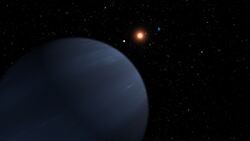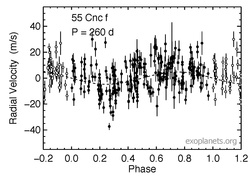Astronomy:55 Cancri f
 An artist's impression of 55 Cancri f. The three bright dots near its star are the three innermost planets. | |
| Discovery | |
|---|---|
| Discovered by | announced by J. Wisdom published by D. Fischer |
| Discovery site | United States |
| Discovery date | 11 April 2005 (announced) 6 November 2007 (published) |
| Doppler spectroscopy | |
| Orbital characteristics | |
| astron|astron|helion}} | 0.833 AU (124,600,000 km) |
| astron|astron|helion}} | 0.730 AU (109,200,000 km) |
| 0.781 ± 0.007 AU (116,800,000 ± 1,000,000 km)[1] | |
| Eccentricity | 0.2 ± 0.2[1] |
| Orbital period | 260.00 ± 1.1[1] d 0.7118 y |
| astron|astron|helion}} | 2,450,080.9108 ± 1.1[1] |
| 181.1 ± 60[1] | |
| Semi-amplitude | 4.879 ± 0.6[1] |
| Star | 55 Cancri A |
| Physical characteristics | |
| Physics | 200–300 K (−73–27 °C; −100–80 °F) |
55 Cancri f (abbreviated 55 Cnc f), also designated Rho1 Cancri f and formally named Harriot /ˈhæriət/,[2] is an exoplanet approximately 41 light-years away from Earth in the constellation of Cancer (the Crab). 55 Cancri f is the fourth known planet (in order of distance) from the star 55 Cancri and the first planet to have been given the designation of "f".[3]
Name
In July 2014 the International Astronomical Union launched NameExoWorlds, a process for giving proper names to certain exoplanets and their host stars.[4] The process involved public nomination and voting for the new names.[5] In December 2015, the IAU announced the winning name was Harriot for this planet.[6] The winning name was submitted by the Royal Netherlands Association for Meteorology and Astronomy of the Netherlands. It honors the astronomer Thomas Harriot.[7]
Discovery
The initial presentation of this planet occurred at a meeting of the American Astronomical Society in April 2005,[8] however it was another two and a half years before the planet was to be published in a peer-reviewed journal.[1] It is the first known planet outside the Solar System to spend its entire orbit within what astronomers call the "habitable zone".[9] Furthermore, its discovery made 55 Cancri the first star other than the Sun known to have at least five planets.
Orbit and mass

55 Cancri f is located about 0.781 AU away from the star and takes 262 days to complete a full orbit.[10] A limitation of the radial velocity method used to detect 55 Cancri f is that only a minimum mass can be obtained, in this case around 0.144 times that of Jupiter, or half the mass of Saturn.[10] A Keplerian fit to the radial velocity data of 55 Cancri A indicates that the orbit is consistent with being circular, however changing the value in a range between 0 and 0.4 does not significantly alter the chi-squared statistic of the fit, thus a representative eccentricity of 0.2±0.2 was assumed.[1] In a Newtonian model which takes interactions between the planets into account, the eccentricity comes out as 0.0002, almost perfectly circular.[1]
Astrometric observations made with the Hubble Space Telescope suggest that the outer planet 55 Cancri d is inclined at 53° with respect to the plane of the sky.[11] The inner planets b and e are inclined at 85°. The inclination of f is unknown.
Characteristics
Since the planet was detected indirectly through observations of its star, properties such as its radius, composition and temperature are unknown. With a mass half that of Saturn,[10] 55 Cancri f is likely to be a gas giant with no solid surface. It orbits in the so-called "habitable zone," which means that liquid water and life could exist on the surface of a possible moon or moons.[9]
It is not known if the composition and appearance is more like that of Saturn or Neptune.[3]
See also
- Appearance of extrasolar planets
- Cancer (Chinese astronomy)
- Lists of exoplanets
- Planetary system
References
- ↑ 1.0 1.1 1.2 1.3 1.4 1.5 1.6 1.7 1.8 Debra A. Fischer; Geoffrey W. Marcy; R. Paul Butler; Steven S. Vogt; Greg Laughlin; Gregory W. Henry et al. (23 December 2007). "Five Planets Orbiting 55 Cancri". Astrophysical Journal 675 (1): 790–801. doi:10.1086/525512. Bibcode: 2008ApJ...675..790F.
- ↑ "Mathematics Pronunciation Guide". http://ceadserv1.nku.edu/longa/classes/2009fall/mat305/resources/pronunciation.html.
- ↑ 3.0 3.1 Shige Abe (12 November 2007). "Researchers Identify First Five-Planet Extrasolar System". NASA Astrobiology. http://astrobiology.nasa.gov/articles/researchers-identify-first-five-planet-extrasolar-system/.
- ↑ NameExoWorlds: An IAU Worldwide Contest to Name Exoplanets and their Host Stars. IAU.org. 9 July 2014
- ↑ "NameExoWorlds The Process". http://nameexoworlds.iau.org/process.
- ↑ Final Results of NameExoWorlds Public Vote Released, International Astronomical Union, 15 December 2015.
- ↑ "NameExoWorlds The Approved Names". http://nameexoworlds.iau.org/names.
- ↑ J. Wisdom (11 April 2005). "A Neptune-sized Planet in the rho1 Cancri System". DDA 36th Meeting, 10–14 April 2005—Session 5 Posters (The American Astronomical Society). http://www.aas.org/publications/baas/v37n2/dda05/29.htm. Retrieved 17 September 2008.
- ↑ 9.0 9.1 Ian Sample, science correspondent (7 November 2007). "Could this be Earth's near twin? Introducing planet 55 Cancri f". The Guardian (London). https://www.theguardian.com/science/2007/nov/07/spaceexploration.
- ↑ 10.0 10.1 10.2 Jean Schneider (2011). "Notes for Planet 55 Cnc f". Extrasolar Planets Encyclopaedia. https://exoplanet.eu/catalog/55_cnc_f--436/.
- ↑ Han et al. (2001). "Preliminary Astrometric Masses for Proposed Extrasolar Planetary Companions". The Astrophysical Journal Letters 548 (1): L57–L60. doi:10.1086/318927. Bibcode: 2001ApJ...548L..57H.
External links
- Ward Glen (8 November 2007). "Astronomers Find Fifth Planet Around 55 Cancri". The Starry Mirror. http://starrymirror.com/5thplanetorbitingstar.htm.
Coordinates: ![]() 08h 52m 35.8s, +28° 19′ 51″
08h 52m 35.8s, +28° 19′ 51″
 |


